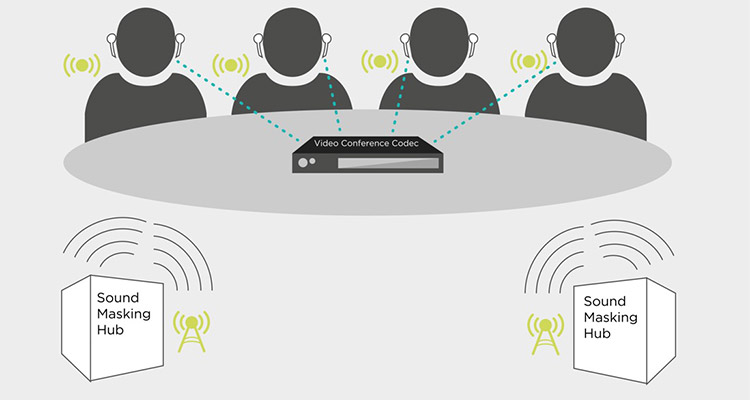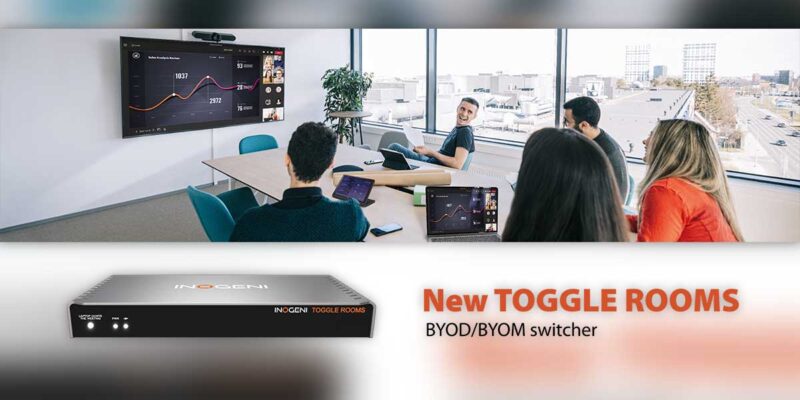The End of Conference Audio — AirPods for AV

By Roland Hemming
RH Consulting
CUE: Dreamy music…
I remember back in late 2016 when a small package arrived — it was a pair of Apple AirPods. These were the latest headphones, designed to compensate for the lack of audio jack on the new iPhone 7. All my friends laughed at me for buying such an expensive gimmick. But they turned out to be the future and had the same impact on corporate AV as the iPhone had on Nokia and Ericsson.
Just two small pods in a tiny charging case. Headphones with built in beamforming microphones and a nifty means of instantly switching between audio on my smartphone, computer and watch.
Looking back, the original models were really clunky but they slowly improved. Now the fifth generation are well established and never need charging because of their kinetic chip. But it is what has gone on behind the scenes that has changed everything.
Yesterday was just a typical day. As usual I was driven to my office. I stepped out popped in my AirPods and my car went off to find a space to park.
‘Welcome to RH Consulting’ breathed the soothing message that everyone hears as they cross the threshold. No loudspeakers anywhere, the system detected my AirPods. At the same time my smartphone automatically downloaded the contextual app for my location. It’s so funny to think that we used to download apps. These days all shops and businesses have a services app that’s downloaded and disposed of as required. These give you a way of finding information, menus, meeting content, connectivity and much else besides.
I had to go straight into a presentation. The app had directed my visitors and they could only access the correct floor and doors appropriate to where they were going.
As we greeted each other, our Airpods all connected to the same channel. There were twelve of us, so we were provided with just the subtlest of amplification to our voices. Then we connected into the videoconference and heard crystal clear audio from each other and from the remote participants too. Later on I showed everyone our new corporate video. It played on the screen nearby, into our ears and for good measure onto everyone’s portable device.
We didn’t have a meeting room, we were sat around a table in a busy office with other meetings nearby. There were also a few solo workers, some of whom where on their own conference calls. You couldn’t hear others outside of our group because of the small modules located around the office area, playing noise for sound masking.
None of us had to do anything for all this to work. All of the connectivity is made possible by ‘AirPods for AV.’ Manufacturers pay a license fee to enable their technology to connect.
Our calendars determined members of the meeting and put us in a group. Otherwise just a double tap on the earphone within a few seconds of each other and in close proximity, connects you all together. Large conferences have a beacon that makes everyone connect.
Once you’ve set up group connection, other devices can access your audio and video as they need to. The video conference system mixed all our microphones and routed everything to the remote locations. Meanwhile our smartphones easily each have enough processing power to carry out acoustic echo cancellation and noise reduction.
During one part of the meeting it broke up into several sub-conversations. The software analysed the pauses between the smaller groups to identify who was speaking to who. It then provided more amplification for the members of each smaller group so they could hear each other more clearly. When it was time to get back to be a combined group I pushed a button and a discrete beep announced that everyone was grouped back together.
The technological breakthrough was when they worked out how to deal with local microphones. If you’ve ever had a mobile phone conversation with a person standing right opposite you know there is a long delay. This was a significant problem to solve.
The AirPod system actually uses two simultaneous methods of audio communication: a direct connection for local spoken audio and networked audio for everything else where a time delay isn’t important. The distributed sound masking modules contain the electronics to act as hubs for the direct, low latency, wireless audio connections.
The seamless mixing and switching of audio sources takes very little getting used to. I tend to keep one AirPod in all the time and then put the other in only when I really need to concentrate on something.
This has all been a natural progression to Bring Your Own Device, but now we come to work with a personalised audio system that just connects to any technology in a variety of environments.
The AV world was the first to roll this out because it enabled a fine tuned experience. It eliminated all the problems we used to have with conference microphones. Nowadays everyone is the same distance from their microphone and we don’t have problems with poor room acoustics. The settings are tuned for each voice. It has saved a lot of money too. No more expensive signal processors, racks of amplifiers or loudspeakers.
The audio manufacturers that survived moved to a software and services model some time ago with the vast majority of the audio processing being handled by our portable devices.
We get quite a few foreigners visiting us. Whilst some of the automatic translation apps are quite good these days, we use a more personalised translation service and our conference simply connects to an available online remote translator. The translation company deals with confidentiality non-compete issues for their workers.
There is an encryption option for users who want to pay for that. We each use our retina scan on our phone to authenticate and then participants share a secure stream.
After a few years of the conference world deploying this technology, then it came to digital signage that just connects when you are nearby. The Audio Privacy Act allowed us to opt out of automatic audio streams, before then it was a nightmare walking through a shopping mall.
I’ve just noticed that cash machines are starting to be equipped with AirPod connections too. Back in 2016 we’d already started moving towards a cashless world. So why do we still have such machines? Well, they didn’t know about the unexpected medical revolution they would bring about, but that’s another story.
Roland Hemming is an audio consultant and project manager and principal at RH Consulting. This blog was reprinted with permission and originally appeared here.





